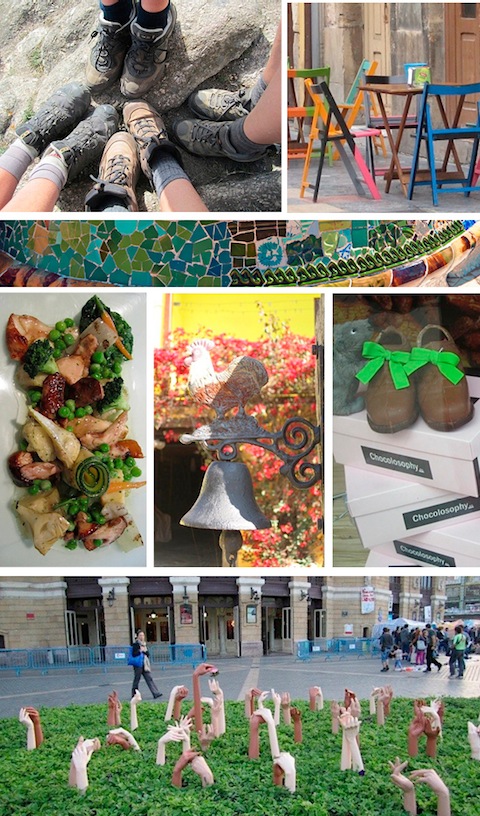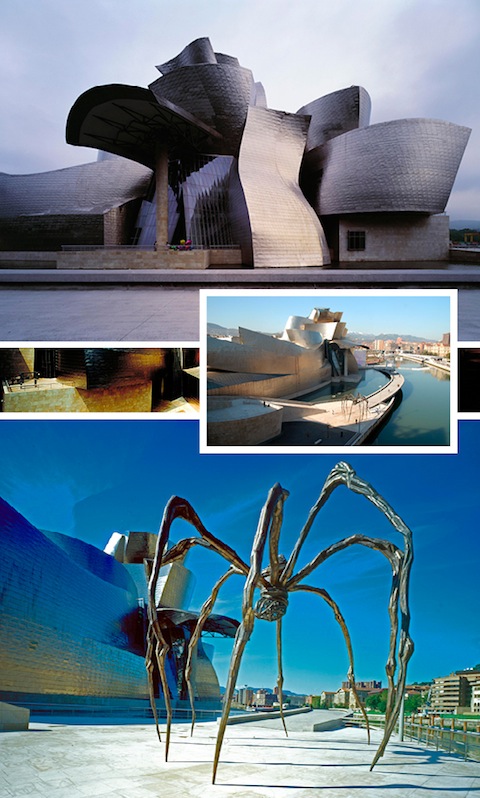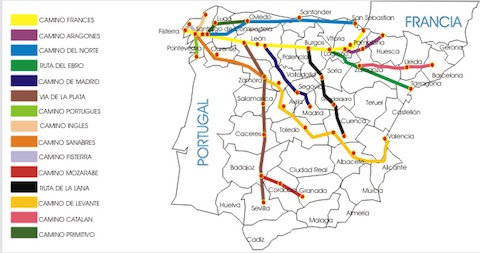
The road less travelled - Camino del Norte, Spain
Guest writer Sharne Wolff (see her regular byline on theartlife.com.au and in Art Monthly Australia) takes the road less travelled through Spain. She follows the yellow arrows of the Camino del Norte, with a side art pilgrimage to Bilbao.

Earlier this year I found myself sitting on a train in Spain …staring at my feet. For the past decade or so several friends and I have embarked on a yearly hike into the wilderness. Over the years we tackled rain and mud on the Milford, Routeburn and Greenstone tracks in New Zealand. We’ve been amazed by February snow on Tasmania’s Overland Track, spotted brumbies in the Victorian Alps, and marvelled at the infinity of night desert skies on Central Australia’s Larapinta Trail. A flippant comment by a friend, however, resulted in an entirely different challenge for this year.

Earlier this year I found myself sitting on a train in Spain …staring at my feet. For the past decade or so several friends and I have embarked on a yearly hike into the wilderness. Over the years we tackled rain and mud on the Milford, Routeburn and Greenstone tracks in New Zealand. We’ve been amazed by February snow on Tasmania’s Overland Track, spotted brumbies in the Victorian Alps, and marvelled at the infinity of night desert skies on Central Australia’s Larapinta Trail. A flippant comment by a friend, however, resulted in an entirely different challenge for this year.
A suggestion that we walk the 900 kilometre ‘Camino del Norte’ in Spain was one I couldn’t resist. Four of us decided to take the challenge. Our feet often became the focus of our trip as we walked, trudged, rambled, sauntered and occasionally limped in a westerly direction across the northern Spanish coast in the timeworn footsteps of St James.
The ‘Camino de Santiago’ (or Way of St James) is a network of ancient tracks that roam through Europe. Each concludes in the ancient Galician capital of Santiago de Compostela in Western Spain. Initially Roman trade routes, they became pilgrimages after the discovery of the tomb of St James around 820AD. Tourists today walk the ‘end’ of these trails to reach the capital – most of which continue for a tad under 1000 kilometres. The French Way (the most popular route) is well set up for tourists with good infrastructure, tour companies, guide books, taxi options, a range of accommodation and numerous cafes - recognising the hundreds, if not thousands, of people walking it’s length each year. As we were to discover, this was not quite the case with our chosen route – the North Way.

From top clockwise: 'These boots were made for walking' after 900kms; Bar in Aviles, Asturias; Park Guell - Barcelona; Chocolate shop in Ribadesella, Asturias; Public art piece outside the Opera House in Bilbao; Brass chicken is taken at one of the many farms we passed along the way - on the road between Santillana del Mar and Cobreces; One course of degustation menu at Etxebarri
I guess we really should have twigged when, after checking in Barcelona and later in several bookshops in the buzzy coastal town of San Sebastian, we had no luck finding any English guidebooks. Hmmm… Oh well, we thought, purchasing the next best thing – the Spanish one - we could still read the contour maps. Surely enough to get by? The pilgrim’s duties were simple – ‘to sleep, eat and walk’ – along with what we considered our fourth duty to ‘follow the yellow arrows’.
While in San Sebastian we also had to obtain our Compostela (the pilgrims ‘passport’) and wait a couple of days for the fourth member of our party to arrive. Despite the incredible attraction of the groovy shops in town, we could not be tempted - having spent the past week or so whittling down our gear to the merest necessities. Everything we needed for the next 6 weeks would have to be carried on our backs. We did, however, indulge in the delicious food of the Basque people and the array of restaurants in the colourful old quarter where we stayed in the flower-covered Pension Amaiur. In the bars that lined the streets nearby, traditional pinxos, tasty tapas type morsels, were served on crusty bread and placed on the counter with a toothpick. Pay only for what you eat. Barmen poured the traditional cider into our glasses from a dangerous height an act that seemed to add both to the charm and the taste. We also discovered to our surprise that San Sebastian is home to more Michelin-starred restaurants than any other European city. And we were about to spend the next 6 weeks walking it all off!
Funnily enough actually leaving San Sebastian proved to be a little harder than we’d imagined. After tightening bootlaces, adjusting packs and putting on sun screen, we walked for about an hour before eventually finding our first yellow flechas (arrow). It was to be the first of hundreds of arrows and signs we searched for. That first day we walked along the coast through the lush green farmland of Basque country with fabulous views of the sea – not unlike the green hills around Byron Bay, the place we normally call home.
Our first week of the Camino was to be a bit of a warm up – partly because we were a little nervous about the prospect of walking 30 kilometres a day but mainly because we knew that we would pass by Bilbao – home of the Frank Gehry designed Guggenheim Museum and a famous restaurant ‘Etxebarri’, not quite as iconic as ‘El Bulli’ but recommended by a friend who’d worked in kitchens with Hester Blumenthal. We deviated from the track and headed in by train into Bilbao for 2 days of art and food. Bilbao was a city that pulsed with youthful energy and an edgy vibe and a total treat. On a perfect Sunday morning we strolled towards the Guggenheim along the Nervion River with an array of engaging public sculpture providing the perfect warm up for the Museum. Approaching from the riverside gave us the chance to view ‘Fog Sculpture #08025 (F.O.G.)’ by Japanese artist Fujiko Nakaya. The glistening titanium of the Guggenheim is visible from a distance and a work of art in itself. The silver shells of the exterior dip and curve around with an ever changing backdrop of city and country while Jeff Koons’ 12 metre ‘Puppy 1992’ sits proudly (in full spring bloom at the time) at the entrance to the Museum. Exploring the museum is like boarding a ship with something to entertain on every deck and great views from the bridge. The ten course degustation menu at Etxebarri wasn’t bad either. The farmhouse-style restaurant was tucked away in the hills near Bilbao. A few wrongs turns by our amiable taxi driver and we finally found it. With a menu comprising courses like coddled egg yolk with shaved mushrooms, goose barnacles and smoked milk ice cream - it was definitely worth getting slightly lost.

Above: Guggenheim Bilbao; Spider sculpture Maman by Louise Bourgeois (images courtesy of Guggenheim Bilbao)
After Bilbao, things got a little more serious. We had planned on walking around 25 kilometres a day but the distance between towns varied a lot so we made a vague plan each night of where we’d sleep the next day. As pilgrims we were permitted to stay in volunteer-run ‘albergues’ at a cost of between 8 and 15 euros per night. This generally meant quite basic accommodation of a comfy mattress, perhaps a kitchen, and occasionally a laundry to wash our clothes. It also meant the company of other walkers – virtually none of whom spoke English as a first language but managed to communicate with us just the same. We stayed in tiny monastery rooms with jolly, hospitable monks, in old school houses sharing with 50 others and occasionally in luxurious ‘no star’ pensions with views of the countryside where the afternoon sun shining on our washing was the best part of the day. Our conversations were littered with similar stories of how to bandage blisters, which were the loudest snorers and where to find the best bar in town. We ate enormous three course lunches from country restaurants where the daily menu always meant a salad entrée and varied only by the dessert (ice cream or yoghurt?). One night we had to choose between tripe and horse for main course. ‘I’ll have both’ said our English companion as quick as a flash. Walking across four provinces meant provincial specialities – a whole food story in each but none more amazing than the day we were given a delicious al fresco snack of thinly sliced cecina (a special dried meat), sheep’s cheese and hand made bread in a random act of kindness by a woman who asked only that we say a prayer for her in Santiago.
Walking in Spain and hiking through the Australian bush couldn’t have been any greater contrast. This wasn’t one-way wilderness out in the middle of nowhere – it was coffee stops, chats to farmers, incredible flowers and vegetable gardens, the hauntingly beautiful sound of goat bells, deviations to interesting towns, drinks in the bar every afternoon, dozens of spectacular churches and amazing food. It was also, of course, quite relentless. Apart from a couple of strange allergic rashes and many angry blisters the four of us survived physically intact and better than many others, some half our age. Surprisingly we didn’t get too lost – but we did often drift off to sleep with yellow arrows swirling in our dreamtime states.
We arrived into Santiago de Compostela at sunset on an evening in late June – 800 kilometres, 5 weeks and a forty-kilometre day walk behind us. ‘… and four Australians’ were the words read by the priest at mass the next day when pilgrims from all over the world came together to celebrate their achievement – the reasons for having done so as varied as the numbers walking the trails. One rest day and we set off again – stepping out for another 4 days and a further 100 kilometres when our trusty feet finally brought us to the ‘edge of the world’ (as it was once thought to be) – the town of Finisterre and the end of an incredible walking odyssey.

The many roads of the Camino de Santiago
Highlights of the Camino del Norte: San Sebastian (food, food, food, and a great all-round coastal city), Bilbao (the Guggenheim & the atmosphere), Santander (an old surf city with a grand entrance via ferry), Santillana del Mar (the town of three lies – there’s no saint, it’s not flat, and it isn’t near the sea), Ribadesella (a lovely harbour town with good chocolate and great restaurants, eg Sibariz), Cudillero (a tiny fishing village with loads of character), Aviles (arty grunge, and wonderful history), Luarca (a character-filled village by the sea), Sobrado dex Monxes (for an unmissable back-to-boarding-school monastery experience), Santiago de Compostela (one of the world’s great small cities – a place to spend some time).

- Sharne Wolff, www.sharnewolff.com.au, all rights reserved. Images, except Guggenheim plate courtesy of writer.From top clockwise: Local transport in Cantabria; Flechas in Basque country; Finisterre sunset; well worn Compostela (the pilgrims ‘passport’); 'the four Aussies' at Finisterre
Websites for more information:
www.caminosantiagodecompostela.com/caminosantiagodelnorte.html
www.asadoretxebarri.com
www.guggenheim.org/bilbao